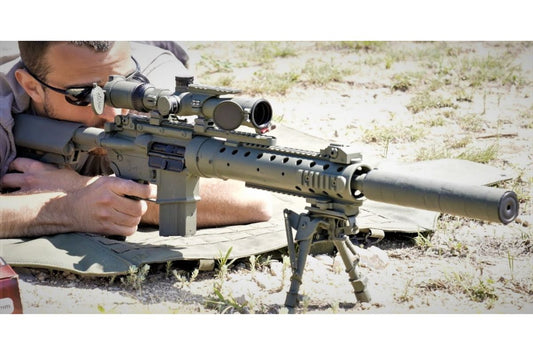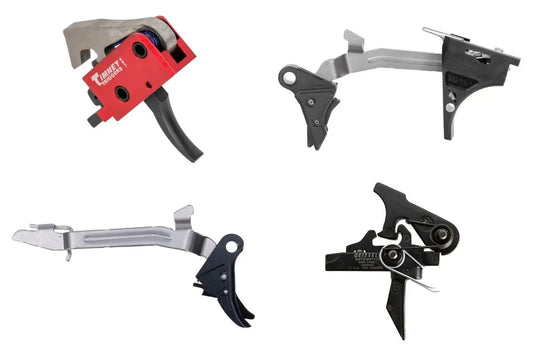Trijicon vs. Holosun Reflex Sights: The 2025 Duty-Grade Red Dot Showdown (With Real-World Picks)
TL;DR for Skimmers: If you want bombproof, proven durability and you don’t mind paying for it, get the Trijicon RMR Type 2 or the Trijicon RCR (closed emitter). If you want maximum features per dollar—multi-reticle, side battery, solar assist, closed emitters at mid-tier prices—get the Holosun 507C X2 or Holosun 509T X2 (closed emitter). For micro/slim pistols: Trijicon RMRcc vs Holosun 407K/507K/EPS Carry—Holosun wins on features/price, Trijicon wins on legacy ruggedness.
Quick Comparison Table (2025 highlights)
|
Model |
Type |
Footprint |
Battery & Life |
Window (approx.) |
Weight |
Notable Features |
Typical Street/Map |
|
Open |
RMR |
CR2032, multi-year; auto & manual modes |
0.87" x 0.63" |
~1.2 oz |
Legendary durability; 20m waterproof; lockout/auto |
MSRP ~$779; street varies. |
|
|
Open (large window) |
RMR |
CR2032, ~3+ yrs |
0.98" x 0.89" |
~1.6 oz |
Huge window, top-load battery; competition favorite |
Street commonly ~$515–$600. |
|
|
Closed |
RMR |
CR2032, ~6 yrs @ setting 5 |
0.88" x 0.64" |
~1.95 oz |
Enclosed emitter, capstan screws, top battery |
~$645–$700. |
|
|
Open |
RMR |
CR1632, up to 50k hr + Solar Failsafe |
~0.63" x 0.91" |
~1.5 oz |
MRS (dot/circle-dot), side battery, Shake Awake |
~$300–$330 typical. |
|
|
Closed |
Dedicated (adapter plates) |
CR1632, up to 50k hr + Solar |
~0.66" x 0.9" |
~1.7 oz |
Titanium body, MRS, Shake Awake |
~$430–$500 typical. |
|
|
Closed micro |
“K”/RMSc |
CR1620, up to 50k hr + Solar |
0.58" x 0.77" |
~1.0 oz |
Sealed emitter, tiny, MRS |
~$330–$400. |
|
|
Open micro |
RMRcc |
CR2032, up to ~4 yrs |
0.76" x 0.56" |
~1.0 oz |
Slim slide fit, Trijicon durability |
~$600–$700. |
|
|
Holosun SCRS (rifle) |
Closed |
509T-pattern mount |
Solar-charging, up to 50k hr |
20mm class |
~ |
Solar-charging, NV modes |
~£260–$300+. |
Note: Specs vary by dot size/version; confirm exact model before buying.
Why these two brands dominate (and when each wins)
The Trijicon thesis: proven, duty-grade ruggedness
Trijicon’s RMR Type 2 has become the reference standard for pistol dots that just don’t die. Waterproof to 20 meters with redesigned electronics, it has a decade+ reputation on service pistols and hard-use carry guns. The newer RCR keeps the RMR footprint but encloses the emitter (better for rain, mud, snow) and moves to a top-load CR2032 with ~6-year life—without Shake Awake gimmicks. Reviewer Sean Curtis summed it up: “The RCR is a very rugged, enclosed emitter red dot… and will cost you a pretty penny.”
For competition or range work, the SRO takes the RMR footprint and adds a panoramic window that simply makes shooting fast—faster. It’s clearer, bigger, top battery, and built for speed over survivability (think USPSA/IDPA rather than a muddy patrol shift). Window: ~0.98" x 0.89".
Expert take: Aaron Cowan (Sage Dynamics) has long argued that quality pistol dots offer a measurable performance edge: “a MRDS is not only more efficient than traditional iron sights for the duty handgun, but … provides distinct advantages.” Trijicon’s RMR helped prove that thesis for duty guns by surviving the drop-tests, round counts, and weather that killed early competitors.
The Holosun thesis: feature density, aggressive pricing, lots of variants
Holosun rapidly iterates. 507C X2 pairs a 2 MOA dot with an optional 32 MOA circle, Solar Failsafe, Shake Awake, and a side battery on a common RMR footprint—usually around the $300 mark. For duty-use, Holosun’s 509T X2 ups the ante with a titanium enclosed housing, MRS reticles, solar assist, and 50k-hour claims. And for slim guns, the EPS Carry delivers a sealed emitter in a teeny package with a real window and IPX8 rating.
Bottom line: Trijicon = “buy once, cry once” durability prestige. Holosun = “90% of the performance + more features at 60% of the price.”
Model-by-model faceoff
Trijicon RMR Type 2 vs. Holosun 507C X2 (general-purpose open reflex)
- RMR Type 2: Redesigned electronics, 20m waterproof, proven duty track record. Multiple dot sizes; manual mode with a 16.5-hour timeout and auto/lockout modes. MSRP often ~$779.
- 507C X2: MRS (2 MOA dot, 32 MOA circle, or both), side battery (change without rezero), Shake Awake, Solar Failsafe, 50k-hr battery claims, typical street ~$300–$330.
Verdict: For a hard-use carry or duty Glock/M&P, we still give the nod to RMR Type 2 for its historic survivability. If you value reticle configurability and price, the 507C X2 is the best bang-for-buck RMR-footprint optic today.
Pros & Cons
- RMR Type 2 Pros: Extreme ruggedness; massive holster/support ecosystem; deep LE pedigree. Cons: Price; bottom battery (must remove to swap) and old-school auto behavior some dislike.
- 507C X2 Pros: Features per dollar; side battery; MRS; Solar/Shake Awake. Cons: Open emitter; long-term “abuse-proof” reputation still trails RMR’s decade head start.
Trijicon RCR vs. Holosun 509T X2 (enclosed-emitter, duty-centric)
- RCR: Closed emitter with RMR footprint, top CR2032, ~6-year life at mid-brightness, capstan screw mount. It’s explicitly aimed at LE/Mil users needing an enclosed dot that still fits RMR cuts. Curtis’ field review calls it “extremely durable” with the durability/value tradeoff plainly noted.
- 509T X2: Closed emitter in Grade 5 titanium, MRS reticles, Solar Failsafe, Shake Awake, ~50k-hr claim. Requires adapter or dedicated cut—not native RMR foot.
Verdict: If you’re already invested in RMR cuts/holsters and you want enclosed, RCR is the cleanest transition. If you value titanium and MRS + Solar and don’t mind the mounting ecosystem, 509T X2 is the value king among closed pistol dots.
Pros & Cons
- RCR Pros: RMR footprint; top battery; closed emitter; duty-first feature set. Cons: Price; boxier profile; fewer reticle options.
- 509T X2 Pros: Titanium durability; MRS/solar/shake; value pricing. Cons: Proprietary footprint/adapters; fewer holster options vs RMR family.
Trijicon SRO vs. Holosun 507C X2 (competition/USPSA lens size play)
- SRO: Massive window (0.98" x 0.89"), top-load CR2032, designed for speed; not the optic you choose for repeated hard edge-to-concrete drop testing.
- 507C X2: Smaller window; more features; cheaper.
Verdict: SRO is still our pick for pure match speed and dot tracking. If you also use the same slide for EDC, consider a second upper or choose a closed emitter. The 507C X2 wins if you need one optic to do a bit of everything on a budget.
Pros & Cons
- SRO Pros: Best-in-class window; top battery; great glass. Cons: Open emitter; more fragile than RMR/RCR; price.
- 507C X2 Pros: Value; MRS; side battery; solar/shake. Cons: Smaller window; open emitter.
Micro/slim pistols: Trijicon RMRcc vs. Holosun 407K/507K & EPS Carry
- RMRcc: Purpose-built for slim slides; CR2032 up to ~4 years, compact window (0.76" x 0.56"). Proven Trijicon electronics and construction, but fewer “extra” features.
- 407K/507K: K-series footprint, 50k-hour claims, side tray battery, Shake Awake. 407K (simple 6 MOA dot) vs 507K (MRS).
- EPS Carry: Closed emitter micro with MRS options, IPX8, distortion-free aspheric lens, 7075 housing—arguably the current micro benchmark on features.
Verdict: On a P365/43X/Hellcat, EPS Carry is our top practical pick for daily carry (closed emitter + features). If you want a “buy once, keep forever” rugged Trijicon with a slim profile, RMRcc remains a strong choice.
Pros & Cons
- RMRcc Pros: Trijicon build quality; simple controls; slim-gun fit. Cons: Price; fewer features; open emitter.
- 407K/507K & EPS Carry Pros: K-footprint friendly; side battery; Shake Awake; EPS Carry is closed. Cons: Holster/plate quirks; long-term abuse-proof rep still maturing vs RMR family.
Price & value reality check (2025 snapshot)
- RMR Type 2 (RM06): MSRP ~$779. Street varies by dot size/color.
- SRO: Commonly ~$515–$600 on deals pages/retailers.
- RCR: ~ $645–$700 based on recent reviews/retail.
- Holosun 507C X2: ~$300–$330 at major retailers.
- Holosun 509T X2: ~$430–$500.
- EPS Carry: ~$330–$400 depending on variant/reticle color.
These are directional; verify current pricing before checkout.
Key decision factors (and how we weight them)
- Emitter style (open vs. enclosed): Enclosed keeps rain/snow/sand off the LED = fewer occlusion failures. This has become the LE/defensive trend, making RCR and 509T/EPS compelling.
- Footprint compatibility: RMR footprint still rules the holster/mounting world. RMR Type 2, SRO, and RCR all keep you in that ecosystem. 509T requires its own plate/footprint.
- Battery changes & runtime: Side/top batteries reduce rezero risk. Holosun’s side trays are a user favorite; SRO/RCR go top-load. Battery life claims: RCR ~6 years @ setting 5; Holosun commonly quotes up to 50k hours for X2 series.
- Reticle philosophy: Simple dots (RMR/RCR) vs. MRS (dot/circle-dot) on Holosun. Big circles aid initial acquisition; dots excel at precision.
- Window size and speed: The SRO window is still unmatched for pure speed and tracking. If concealment or durability is primary, choose smaller or enclosed.
- Durability pedigree: Trijicon’s RMR family is the long-standing durability benchmark. Holosun’s 509T (titanium) and EPS/EPS Carry are closing the gap, especially in sealed form factors.
What the experts say
- Aaron Cowan (Sage Dynamics) on duty pistol dots: “a MRDS is not only more efficient than traditional iron sights… [it] provides distinct advantages.” The white paper and years of testing underpin why RMR-class optics took off in patrol work.
- Sean Curtis (Pew Pew Tactical) on RCR: “The RCR is a very rugged, enclosed emitter red dot that has all the features you need… and will cost you a pretty penny.” He also highlights the six-year battery life and RMR-foot compatibility.
Use-case prescriptions (pick your lane)
- Hard-use duty / EDC in variable weather:
- #1: Trijicon RCR (closed, RMR footprint).
- #2 (value): Holosun 509T X2 (closed, titanium, MRS).
- General-purpose carry/range (open emitter, RMR footprint):
- #1: Trijicon RMR Type 2
- #2 (value): Holosun 507C X2.
- Competition / pure speed:
- Trijicon SRO (giant window, top battery).
- Subcompact/slim pistols:
- Tough & simple: Trijicon RMRcc.
- Feature-rich / closed emitter: Holosun EPS Carry or 507K (where compatible).
Buying notes, mount/holster fit & gotchas
- RMR footprint rules: You’ll have the most direct-mount slides, plates, and holster compatibility with RMR/RMR-height optics (RMR, SRO, RCR maintains RMR footprint).
- 509T plate needs: The 509T ships with its own mounting hardware and often needs an adapter for slides cut for RMR; verify your plate or have a dedicated cut.
- Top/side battery = fewer rezero events: SRO/RCR = top-load; Holosun X2 pistols use side trays; RMR Type 2 is bottom-load (remove optic to change unless slide has access).
- Brightness control behavior: RMR/RMRcc have auto + manual with a 16.5-hour manual timeout; RCR is manual-only (and lockable); Holosun often adds a Lock Mode to prevent inadvertent button presses.
Rifle/offset dot aside: Holosun SCRS vs. pistol dots
If you need a closed-emitter micro for rifles (top or offset), the Holosun SCRS uses solar charging with long runtime, includes NV settings, and ships with a lower 1/3 co-witness mount—impressive capability for the money.
Final recommendations by shooter profile
- Police patrol / duty gun: RCR if you want closed emitter + RMR footprint today. If budget is constrained or you want MRS/solar, 509T X2 is the pragmatic pick.
- Concealed carry in rainy/sandy climates: EPS Carry on slim pistols; RCR/509T on duty-size pistols. Closed emitter minimizes occlusion risk.
- Competition / gamer gun: SRO for the glass; have a separate carry slide if you EDC.
- One-optic-to-do-most-things on a budget: 507C X2 wins value and versatility.
- “Buy once, cry once” durability: RMR Type 2 remains a safe long-term bet.
Pros & Cons—Brand-level
Trijicon (RMR/SRO/RCR)
- Pros
- Best-in-class durability pedigree (RMR family).
- RMR footprint compatibility across guns/holsters/plates.
- RCR brings enclosed emitter without abandoning RMR footprint; top battery.
- SRO window is unmatched for tracking the dot at speed.
- Cons
- Higher prices across the board.
- Fewer “quality-of-life” features (no Shake Awake/Solar), more conservative feature set.
- RMR’s bottom battery is dated (though reliable).
Holosun (507C/509T/EPS family)
- Pros
- Feature density: MRS, Solar Failsafe, Shake Awake, side battery trays.
- Aggressive pricing; excellent value.
- Closed-emitter options in multiple sizes (509T, EPS/EPS Carry) including titanium.
- Cons
- Mixed mounting ecosystems (e.g., 509T plates), fewer decades-deep duty records vs. RMR.
- Open-emitter SKUs (507C) still subject to environmental occlusion.
Specific product links (high-quality picks)
- Trijicon RMR Type 2 (RM06 3.25 MOA): Product page
- Trijicon SRO (2.5 MOA): Product page
- Trijicon RCR: Product family • Field review (pricing/specs context): Pew Pew Tactical
- Holosun 507C X2: Product page
- Holosun 509T X2: Product page
- Holosun EPS Carry: Product page
- Trijicon RMRcc: Product page
The decision in one sentence
- Duty/Professional: Buy RCR (or RMR Type 2 if you want open emitter).
- Value/Features: Buy 509T X2 (enclosed) or 507C X2 (open).
- Competition: Buy SRO.
- Slim carry: Buy EPS Carry (closed) or RMRcc (Trijicon loyalists).
FAQ
Is the RMR Type 2 still worth it in 2025?
Yes. It remains the durability baseline for pistol RDS with a gigantic ecosystem. If you don’t need enclosed, it’s hard to “age out” an RMR Type 2.
Is enclosed worth the extra bulk?
For duty/EDC in real weather: yes. It keeps debris from killing your dot. The RCR and 509T/EPS exist for this reason.
Do I need Shake Awake/Solar?
Convenient, not essential. Trijicon avoids them and instead delivers years of always-on runtime (RCR ~6 years @ mid setting). Holosun’s features help casual users stretch battery intervals.
What’s the fastest dot to shoot?
SRO—thanks to that massive window. Just accept it’s more “competition-tuned” than “duty-tuned.”
Will my existing holster work?
If it fits RMR height/profile, the RMR and SRO are usually fine; RCR can be boxier (check holster charts); 509T needs an appropriate adapter and holster clearance.
👉 Shop current deals on Trijicon & Holosun reflex sights at OpticsPlanet.com.




